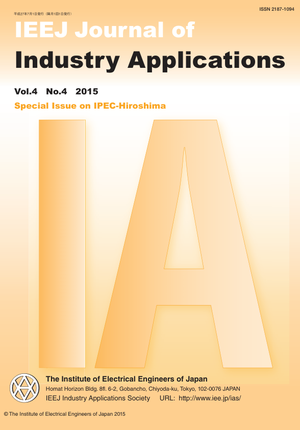Design of Compensation Capacitor in S/P Topology of Inductive Power Transfer System with Buck or Boost Converter on Secondary Side
Design of Compensation Capacitor in S/P Topology of Inductive Power Transfer System with Buck or Boost Converter on Secondary Side
カテゴリ: 論文誌(論文単位)
グループ名: 【D】産業応用部門(英文)
発行日: 2015/07/01
タイトル(英語): Design of Compensation Capacitor in S/P Topology of Inductive Power Transfer System with Buck or Boost Converter on Secondary Side
著者名: Ryosuke Ota (Tokyo University of Science), Nobukazu Hoshi (Tokyo University of Science), Junnosuke Haruna (Utsunomiya University)
著者名(英語): Ryosuke Ota (Tokyo University of Science), Nobukazu Hoshi (Tokyo University of Science), Junnosuke Haruna (Utsunomiya University)
キーワード: Wireless power transfer system,inductive power transfer,compensation capacitor,secondary-side converter
要約(英語): When an inductive power transfer system is applied to a battery charger for electric vehicles, a diode bridge rectifier with a dc-dc converter, called a secondary-side converter in this paper, is connected to the secondary side of the resonant circuit in order to regulate the current and voltage of the battery. A compensation capacitor is typically used to improve the input power factor in an inductive power transfer system, and a resonant circuit is configured. This paper presents a design method for the primary compensation capacitor in an inductive power transfer system with series compensation on the primary side and parallel compensation on the secondary side (S/P topology) to connect a boost or buck converter via a rectifier circuit on the receiving side. For the S/P topology, the capacitance of the primary-side compensation capacitor influences the duty ratio of the switch used in the secondary-side converter because it affects the input-to-output voltage ratio of the resonant circuit. Further, the duty ratio of the secondary-side converter affects the resonant-circuit efficiency. In addition, the primary compensation capacitance affects the output power factor of the inverter, which is connected to the primary side of the resonant circuit. Therefore, the capacitance of the primary-side compensation capacitor also affects the inverter efficiency and resonant-circuit efficiency. In this paper, a primary-side capacitor design method is examined. The results show that the optimum capacitance using a buck converter differs from that using a boost converter.
本誌: IEEJ Journal of Industry Applications Vol.4 No.4 (2015) Special Issue on IPEC-Hiroshima
本誌掲載ページ: 476-485 p
原稿種別: 論文/英語
電子版へのリンク: https://www.jstage.jst.go.jp/article/ieejjia/4/4/4_476/_article/-char/ja/
受取状況を読み込めませんでした


